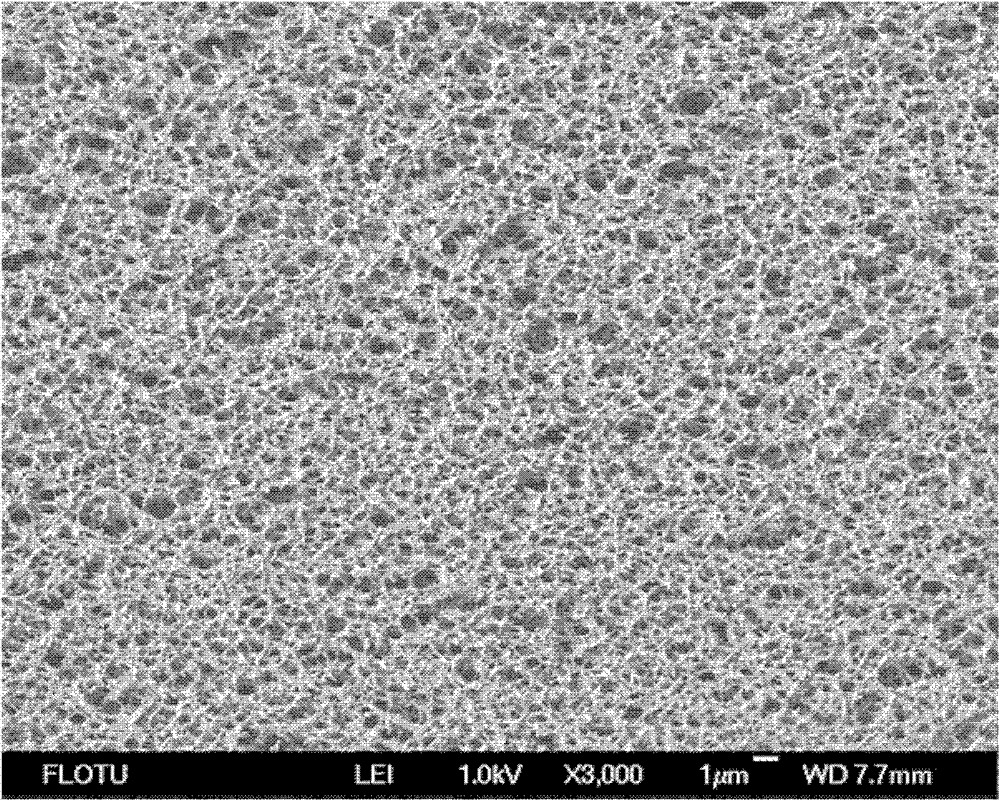Method for preparing ethylene-trifluorochlor oethylene copolymer porous membrane
A technology of chlorotrifluoroethylene and copolymers, applied in chemical instruments and methods, membrane technology, semi-permeable membrane separation, etc., can solve the problems of poor mechanical properties and low porosity, and achieve high mechanical strength, high porosity, The effect of widening the concentration selection range
- Summary
- Abstract
- Description
- Claims
- Application Information
AI Technical Summary
Problems solved by technology
Method used
Image
Examples
Embodiment 1
[0036] With ethylene-chlorotrifluoroethylene copolymer and diethyl phthalate, its component is that the mass percent composition of ethylene-trifluoroethylene copolymer is 10wt%, and the mass percent composition of diethylphthalate is 90 wt%, put it into a high-temperature stirred tank and heat up to 240 degrees Celsius, stir and mix evenly to form a polymer homogeneous solution, and let it stand for 24 hours. Then the polymer homogeneous solution was directly hang-coated on the support net to form a flat film with a film thickness of 200 μm, and entered into a cooling liquid bath at 30°C to solidify the solution into a film by phase separation. The cooling liquid was a water bath. The cured flat film was extracted with ethanol and dried.
[0037]The cross-section of the membrane is a uniform sponge-like structure with a porosity of 84% and a breaking strength of 3.25MPa.
Embodiment 2
[0039] With ethylene-chlorotrifluoroethylene copolymer and diethyl phthalate, its component is that the mass percent composition of ethylene-trifluoroethylene copolymer is 28wt%, and the mass percent composition of diethylphthalate is 72 wt%, put it into a high-temperature stirred tank and heat up to 240 degrees Celsius, stir and mix evenly to form a polymer homogeneous solution, and let it stand for 24 hours. Then the polymer homogeneous solution was directly hang-coated on the support net to form a flat film with a film thickness of 200 μm, and entered into a cooling liquid bath at 30°C to solidify the solution into a film by phase separation. The cooling liquid was a glycerol bath. The cured flat film was extracted with ethanol and dried.
[0040] The cross-section of the membrane is a uniform sponge-like structure with a porosity of 71% and a breaking strength of 10.58MPa.
Embodiment 3
[0042] With ethylene-chlorotrifluoroethylene copolymer and diethyl phthalate, its component is that the mass percent composition of ethylene-trifluoroethylene copolymer is 60wt%, and the mass percent composition of diethylphthalate is 40 wt%, put it into a high-temperature stirred tank and heat up to 250 degrees Celsius, stir and mix evenly to form a polymer homogeneous solution, and let it stand for 24 hours. Then the polymer homogeneous solution was directly hang-coated on the support net to form a flat film with a film thickness of 200 μm, and entered into a cooling liquid bath at 30°C to solidify the solution into a film by phase separation. The cooling liquid was a water bath. The cured flat film was extracted with ethanol and dried.
[0043] The cross-section of the membrane is a uniform sponge-like structure with a porosity of 31% and a breaking strength of 14.59MPa.
PUM
| Property | Measurement | Unit |
|---|---|---|
| breaking strength | aaaaa | aaaaa |
| breaking strength | aaaaa | aaaaa |
| breaking strength | aaaaa | aaaaa |
Abstract
Description
Claims
Application Information
 Login to View More
Login to View More - R&D
- Intellectual Property
- Life Sciences
- Materials
- Tech Scout
- Unparalleled Data Quality
- Higher Quality Content
- 60% Fewer Hallucinations
Browse by: Latest US Patents, China's latest patents, Technical Efficacy Thesaurus, Application Domain, Technology Topic, Popular Technical Reports.
© 2025 PatSnap. All rights reserved.Legal|Privacy policy|Modern Slavery Act Transparency Statement|Sitemap|About US| Contact US: help@patsnap.com



